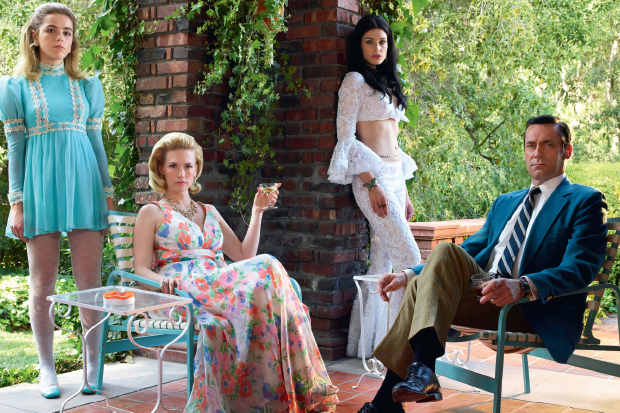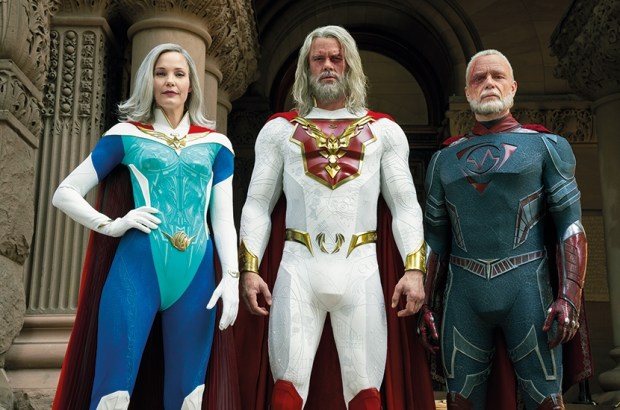There’s a scene in the finale of season six that embodies everything that’s so right and so wrong with Mad Men. Don Draper, that fathomless enigma of a Madison Avenue copywriting anti-hero, is pitching for the Hershey’s chocolate account. Hershey’s represents that dream combination — an American brand legend that has never really advertised before. So winning this deal really matters.
Draper — as always — is pitch-perfect. Selling products is about telling stories. And the story here is about how good the young Don Draper felt when his Daddy took him into a store and offered to buy him anything he wanted. Naturally he chose a Hershey’s bar. The clients are desperately impressed and on the verge of signing a deal.
Unfortunately, Draper has been drinking heavily before the meeting. Having told the clients what they want to hear, he now tells them the truth: that Hershey’s is a product that doesn’t really need advertising and that his blissful childhood was a lie — he was actually raised a hated child in a whorehouse and whenever he ate Hershey’s it was in misery and alone. The clients make their excuses and leave.
Now it’s a great scene — exquisitely acted, sharply scripted, charged with deep meaning about the nature of advertising — but it’s also a fundamentally dishonest one. Draper is in the throes of an alcohol-enhanced nervous breakdown. In the same episode, we see him lying in the drunk tank, having been picked up by the police for beating up a pastor who tried talking him into temperance. Before the meeting he has a huge slug of whiskey. So what kind of superman is he that he can always look immaculate and glamorous and function perfectly, even while drunk — yet simultaneously blow his career, as required by the exigencies of plot tension, in the next instant?
A typical Mad Men superman is what. For they’re all at it, not just Don: Roger Sterling, the perma-irritating, annoyingly dressed heir to his more talented father’s agency; Pete Campbell, the serially unfaithful upper-class bastard. The womenfolk too, to a degree — goofily bangable Peggy, thick but immaculate Betty, voluptuously formidable Joan. They chain-smoke and booze and fornicate like there are no consequences, for in Mad Men there really aren’t. Sure your career might go up and down and there might be some heartbreak, but you never once lose hold of the really important things — your looks, your style and your cool.
This, I’m sure, is why art directors and stylists (and of course copywriters) are so especially drawn to Mad Men; why for them it’s just the greatest TV series ever which will never be surpassed. What it shows is the Sixties as they’d have liked it to have been had they personally been styling it: with everyone looking fab in op art dresses and oh-my-God haircuts and hilarious sideburns and Eames chairs and Martinis and cigarettes and suits so slick and immaculately cut that basically all men’s fashion since 2007 (when the series was first broadcast) has more or less been dictated by Mad Men retro chic.
Obviously this is its great strength: besides making Mad Men at once achingly nostalgia-inducing (even the washed-out colouring is right, just like an ad from a Sixties magazine) and smoulderingly gorgeous to look at (each episode is the equivalent of an hour with the beautiful people in the latest boutique hotel), it also points up the underlying theme, which is about identity, and the contrast between surface gloss and concealed dross.
But it’s also, I’d argue, its main weakness. Almost never have I been able to watch a Mad Men scene without being acutely conscious of the effort that went into making it: everything from the awkwardness of the actors having to smoke so much in (what now seem) the unlikeliest of situations (on a plane before take-off; preparing food for the kids’ party; in bed) to the sourcing of every last über-recherché bit of collectible furniture to the fabric patterns and cuts so bang on trend for the specific year in which each episode is set that you think less of the period itself than of the style books the researchers must have consulted to get it exactly right.
All this stems, of course, from the series’ brilliant, obsessive creator Matthew Weiner (a protégé of David Chase, the man behind of The Sopranos — on which Weiner spent several seasons as writer/producer) whose anally retentive attention to detail is legendary. On one occasion, he famously dismissed a bowl of plump, shiny apples from the set on the grounds that Sixties fruit was smaller, dumpier than today’s. Quite right, I’m sure. But the odd effect of all this perfectionism, rather than enhance the series’ realism, is to draw attention to its artifice.
This is why, as the second half of Mad Men’s seventh and final season approaches, I find myself unable to get quite so depressed at its imminent demise as I did with, say, The Sopranos or Breaking Bad. It’s great to look at; I loved the politically incorrect escapism of all that smoking and misogyny; and its depiction of low, Machiavellian office politics and advertising will surely never be surpassed. But one episode did often seem rather like another, and at the end you felt slightly hollow and cheated and depressed, as unfortunately you do with things where style takes precedence over content. Maybe, though, I’m being unsophisticated. Maybe that was the whole point.
Got something to add? Join the discussion and comment below.
Get 10 issues for just $10
Subscribe to The Spectator Australia today for the next 10 magazine issues, plus full online access, for just $10.
Mad Men season 7 part 2 airs on Sky Atlantic on 9 April.
You might disagree with half of it, but you’ll enjoy reading all of it. Try your first month for free, then just $2 a week for the remainder of your first year.















Comments
Don't miss out
Join the conversation with other Spectator Australia readers. Subscribe to leave a comment.
SUBSCRIBEAlready a subscriber? Log in